Abstract
Previous studies have demonstrated that bispecific hybrid antibodies produced by cell-cell fusion or chemically conjugated heteroaggregates can direct cytotoxic T lymphocytes to kill target cells for which they have no intrinsic specificity, a phenomenon we call effector cell retargeting (ECR). These studies used bispecific reagents with one specificity directed to CD3 or Ti on the effector cell and the other directed to a target cell antigen. To avoid the need to create different hybrid hybridomas for each target antigen we have developed a universal means to elicit ECR through the use of an antiglobulin step. We have constructed a bispecific hybrid antibody with dual specificity for CD3 and a rat immunoglobulin light chain allotype. This bispecific antibody could mediate ECR to a range of target cells, each coated with distinct surface-binding rat monoclonal antibodies. A particular advantage of targeting to surface-bound monoclonal antibodies is that all other available effector systems may also attack the same antibody-coated target cell.
Full text
PDF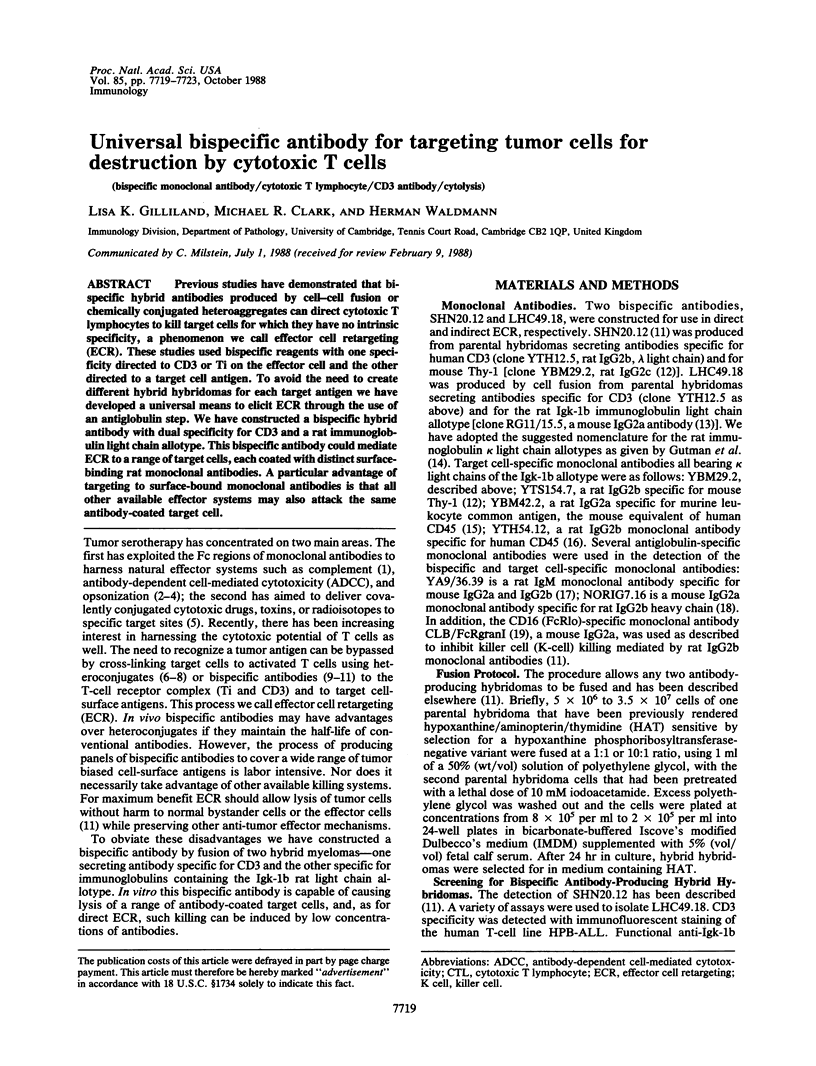
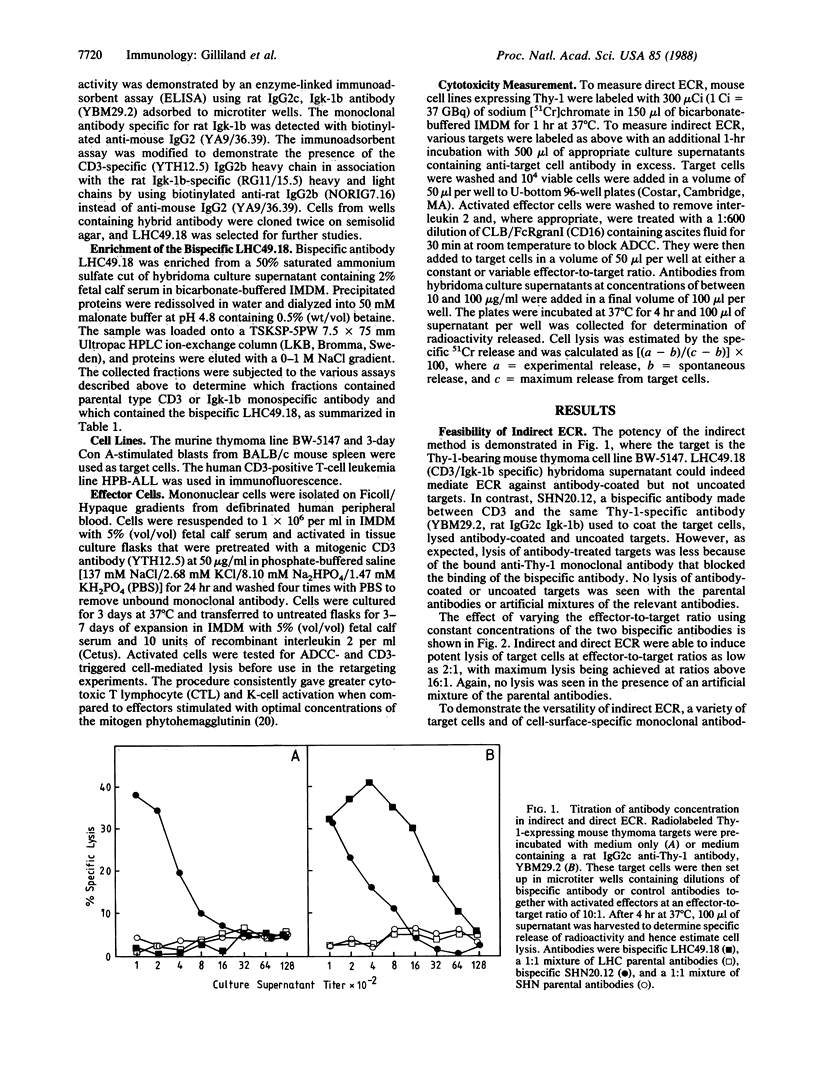
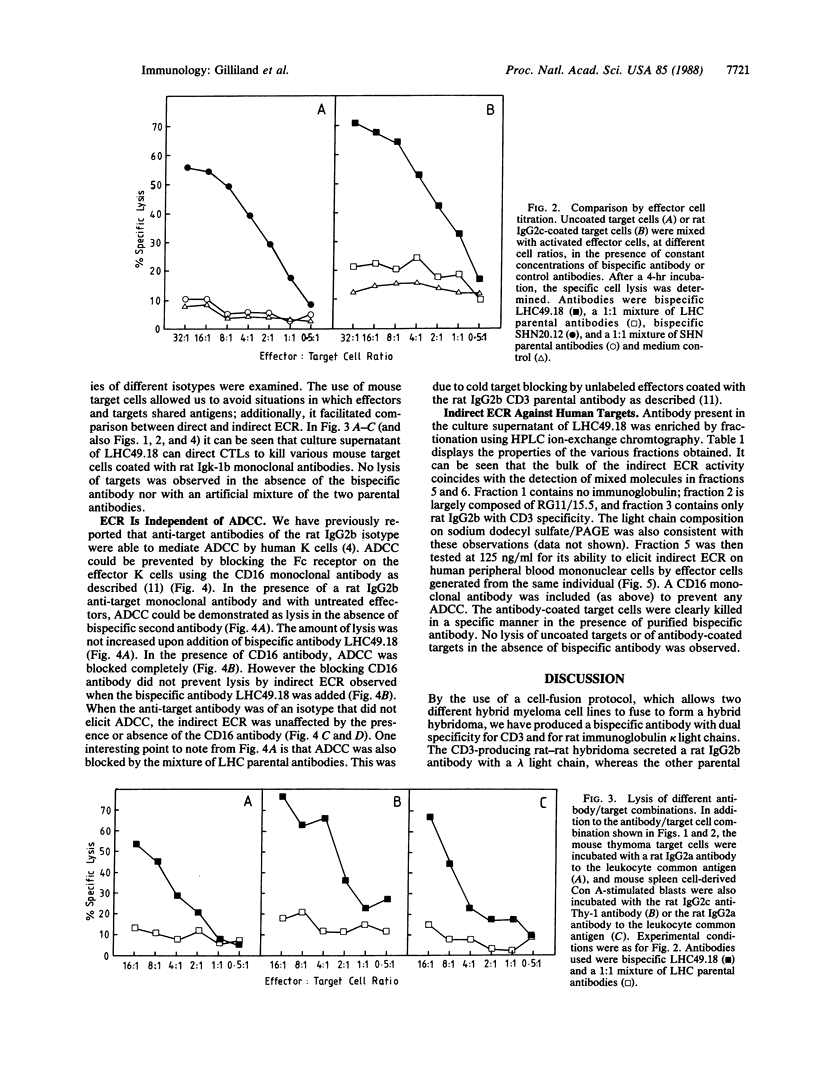
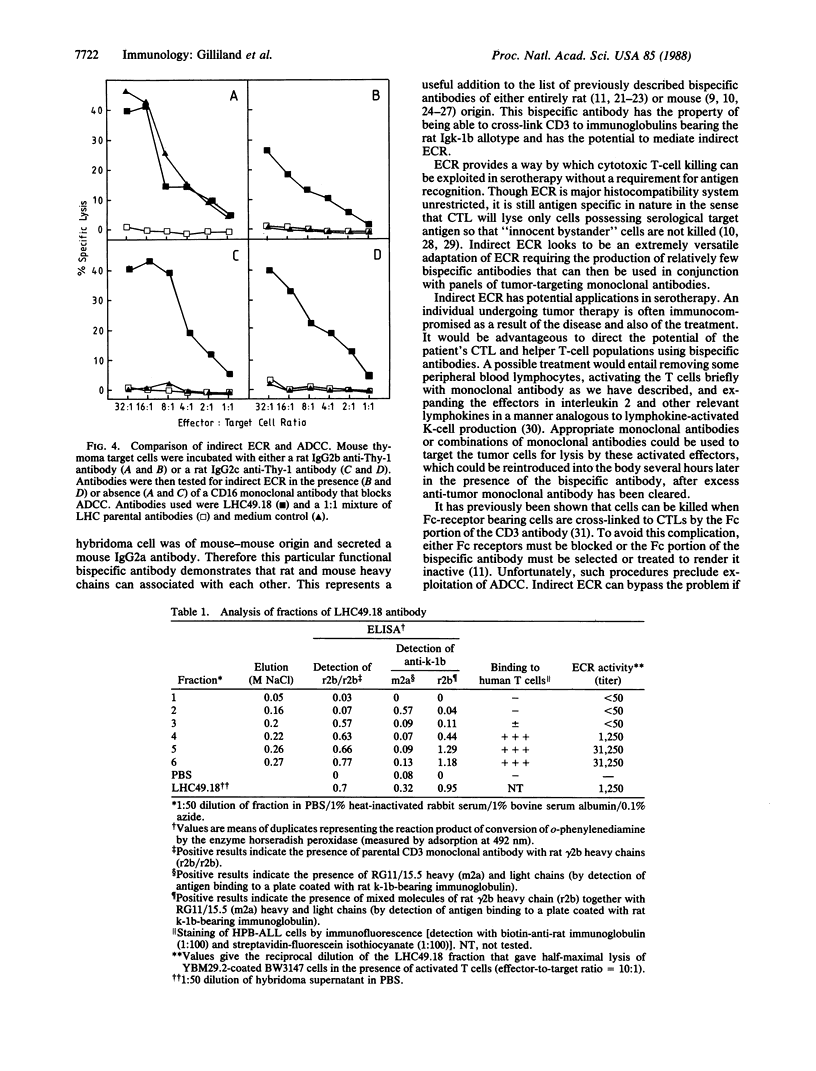
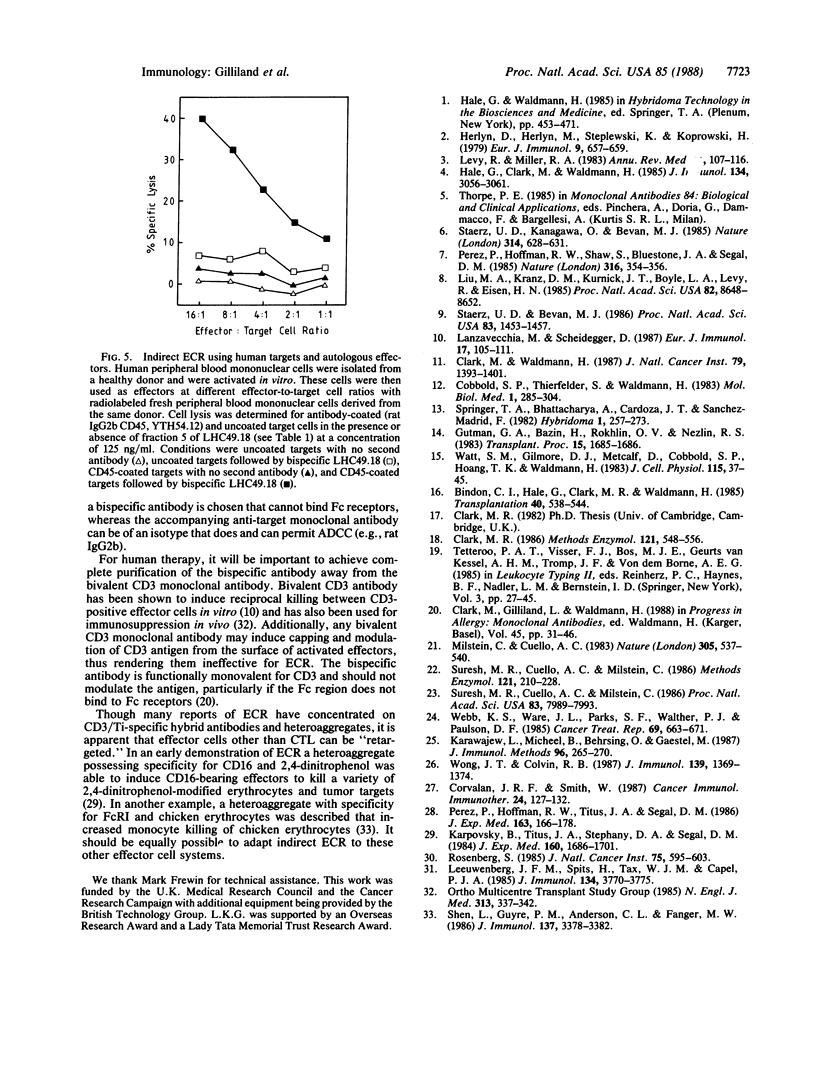
Selected References
These references are in PubMed. This may not be the complete list of references from this article.
- Bindon C. I., Hale G., Clark M., Waldmann H. Therapeutic potential of monoclonal antibodies to the leukocyte-common antigen. Synergy and interference in complement-mediated lysis. Transplantation. 1985 Nov;40(5):538–544. doi: 10.1097/00007890-198511000-00013. [DOI] [PubMed] [Google Scholar]
- Clark M. R. The detection and characterization of antigen-specific monoclonal antibodies using anti-immunoglobulin isotype antibodies coupled to red blood cells. Methods Enzymol. 1986;121:548–556. doi: 10.1016/0076-6879(86)21054-x. [DOI] [PubMed] [Google Scholar]
- Clark M. R., Waldmann H. T-cell killing of target cells induced by hybrid antibodies: comparison of two bispecific monoclonal antibodies. J Natl Cancer Inst. 1987 Dec;79(6):1393–1401. [PubMed] [Google Scholar]
- Cobbold S. P., Thierfelder S., Waldmann H. Immunosuppression with monoclonal antibodies. A model to determine the rules for effective serotherapy. Mol Biol Med. 1983 Oct;1(3):285–304. [PubMed] [Google Scholar]
- Corvalan J. R., Smith W. Construction and characterisation of a hybrid-hybrid monoclonal antibody recognising both carcinoembryonic antigen (CEA) and vinca alkaloids. Cancer Immunol Immunother. 1987;24(2):127–132. doi: 10.1007/BF00205589. [DOI] [PMC free article] [PubMed] [Google Scholar]
- Hale G., Clark M., Waldmann H. Therapeutic potential of rat monoclonal antibodies: isotype specificity of antibody-dependent cell-mediated cytotoxicity with human lymphocytes. J Immunol. 1985 May;134(5):3056–3061. [PubMed] [Google Scholar]
- Herlyn D., Herlyn M., Steplewski Z., Koprowski H. Monoclonal antibodies in cell-mediated cytotoxicity against human melanoma and colorectal carcinoma. Eur J Immunol. 1979 Aug;9(8):657–659. doi: 10.1002/eji.1830090817. [DOI] [PubMed] [Google Scholar]
- Karawajew L., Micheel B., Behrsing O., Gaestel M. Bispecific antibody-producing hybrid hybridomas selected by a fluorescence activated cell sorter. J Immunol Methods. 1987 Feb 11;96(2):265–270. doi: 10.1016/0022-1759(87)90323-1. [DOI] [PubMed] [Google Scholar]
- Karpovsky B., Titus J. A., Stephany D. A., Segal D. M. Production of target-specific effector cells using hetero-cross-linked aggregates containing anti-target cell and anti-Fc gamma receptor antibodies. J Exp Med. 1984 Dec 1;160(6):1686–1701. doi: 10.1084/jem.160.6.1686. [DOI] [PMC free article] [PubMed] [Google Scholar]
- Lanzavecchia A., Scheidegger D. The use of hybrid hybridomas to target human cytotoxic T lymphocytes. Eur J Immunol. 1987 Jan;17(1):105–111. doi: 10.1002/eji.1830170118. [DOI] [PubMed] [Google Scholar]
- Leeuwenberg J. F., Spits H., Tax W. J., Capel P. J. Induction of nonspecific cytotoxicity by monoclonal anti-T3 antibodies. J Immunol. 1985 Jun;134(6):3770–3775. [PubMed] [Google Scholar]
- Levy R., Miller R. A. Biological and clinical implications of lymphocyte hybridomas: tumor therapy with monoclonal antibodies. Annu Rev Med. 1983;34:107–116. doi: 10.1146/annurev.me.34.020183.000543. [DOI] [PubMed] [Google Scholar]
- Liu M. A., Kranz D. M., Kurnick J. T., Boyle L. A., Levy R., Eisen H. N. Heteroantibody duplexes target cells for lysis by cytotoxic T lymphocytes. Proc Natl Acad Sci U S A. 1985 Dec;82(24):8648–8652. doi: 10.1073/pnas.82.24.8648. [DOI] [PMC free article] [PubMed] [Google Scholar]
- Milstein C., Cuello A. C. Hybrid hybridomas and their use in immunohistochemistry. Nature. 1983 Oct 6;305(5934):537–540. doi: 10.1038/305537a0. [DOI] [PubMed] [Google Scholar]
- Perez P., Hoffman R. W., Shaw S., Bluestone J. A., Segal D. M. Specific targeting of cytotoxic T cells by anti-T3 linked to anti-target cell antibody. Nature. 1985 Jul 25;316(6026):354–356. doi: 10.1038/316354a0. [DOI] [PubMed] [Google Scholar]
- Perez P., Hoffman R. W., Titus J. A., Segal D. M. Specific targeting of human peripheral blood T cells by heteroaggregates containing anti-T3 crosslinked to anti-target cell antibodies. J Exp Med. 1986 Jan 1;163(1):166–178. doi: 10.1084/jem.163.1.166. [DOI] [PMC free article] [PubMed] [Google Scholar]
- Rosenberg S. Lymphokine-activated killer cells: a new approach to immunotherapy of cancer. J Natl Cancer Inst. 1985 Oct;75(4):595–603. [PubMed] [Google Scholar]
- Shen L., Guyre P. M., Anderson C. L., Fanger M. W. Heteroantibody-mediated cytotoxicity: antibody to the high affinity Fc receptor for IgG mediates cytotoxicity by human monocytes that is enhanced by interferon-gamma and is not blocked by human IgG. J Immunol. 1986 Dec 1;137(11):3378–3382. [PubMed] [Google Scholar]
- Springer T. A., Bhattacharya A., Cardoza J. T., Sanchez-Madrid F. Monoclonal antibodies specific for rat IgG1, IgG2a, and IgG2b subclasses, and kappa chain monotypic and allotypic determinants: reagents for use with rat monoclonal antibodies. Hybridoma. 1982;1(3):257–273. doi: 10.1089/hyb.1.1982.1.257. [DOI] [PubMed] [Google Scholar]
- Staerz U. D., Bevan M. J. Hybrid hybridoma producing a bispecific monoclonal antibody that can focus effector T-cell activity. Proc Natl Acad Sci U S A. 1986 Mar;83(5):1453–1457. doi: 10.1073/pnas.83.5.1453. [DOI] [PMC free article] [PubMed] [Google Scholar]
- Staerz U. D., Kanagawa O., Bevan M. J. Hybrid antibodies can target sites for attack by T cells. Nature. 1985 Apr 18;314(6012):628–631. doi: 10.1038/314628a0. [DOI] [PubMed] [Google Scholar]
- Suresh M. R., Cuello A. C., Milstein C. Advantages of bispecific hybridomas in one-step immunocytochemistry and immunoassays. Proc Natl Acad Sci U S A. 1986 Oct;83(20):7989–7993. doi: 10.1073/pnas.83.20.7989. [DOI] [PMC free article] [PubMed] [Google Scholar]
- Suresh M. R., Cuello A. C., Milstein C. Bispecific monoclonal antibodies from hybrid hybridomas. Methods Enzymol. 1986;121:210–228. doi: 10.1016/0076-6879(86)21019-8. [DOI] [PubMed] [Google Scholar]
- Watt S. M., Gilmore D. J., Metcalf D., Cobbold S. P., Hoang T. K., Waldmann H. Segregation of mouse hemopoietic progenitor cells using the monoclonal antibody, YBM/42. J Cell Physiol. 1983 Apr;115(1):37–45. doi: 10.1002/jcp.1041150107. [DOI] [PubMed] [Google Scholar]
- Webb K. S., Ware J. L., Parks S. F., Walther P. J., Paulson D. F. Evidence for a novel hybrid immunotoxin recognizing ricin A-chain by one antigen-combining site and a prostate-restricted antigen by the remaining antigen-combining site: potential for immunotherapy. Cancer Treat Rep. 1985 Jun;69(6):663–672. [PubMed] [Google Scholar]
- Wong J. T., Colvin R. B. Bi-specific monoclonal antibodies: selective binding and complement fixation to cells that express two different surface antigens. J Immunol. 1987 Aug 15;139(4):1369–1374. [PubMed] [Google Scholar]


